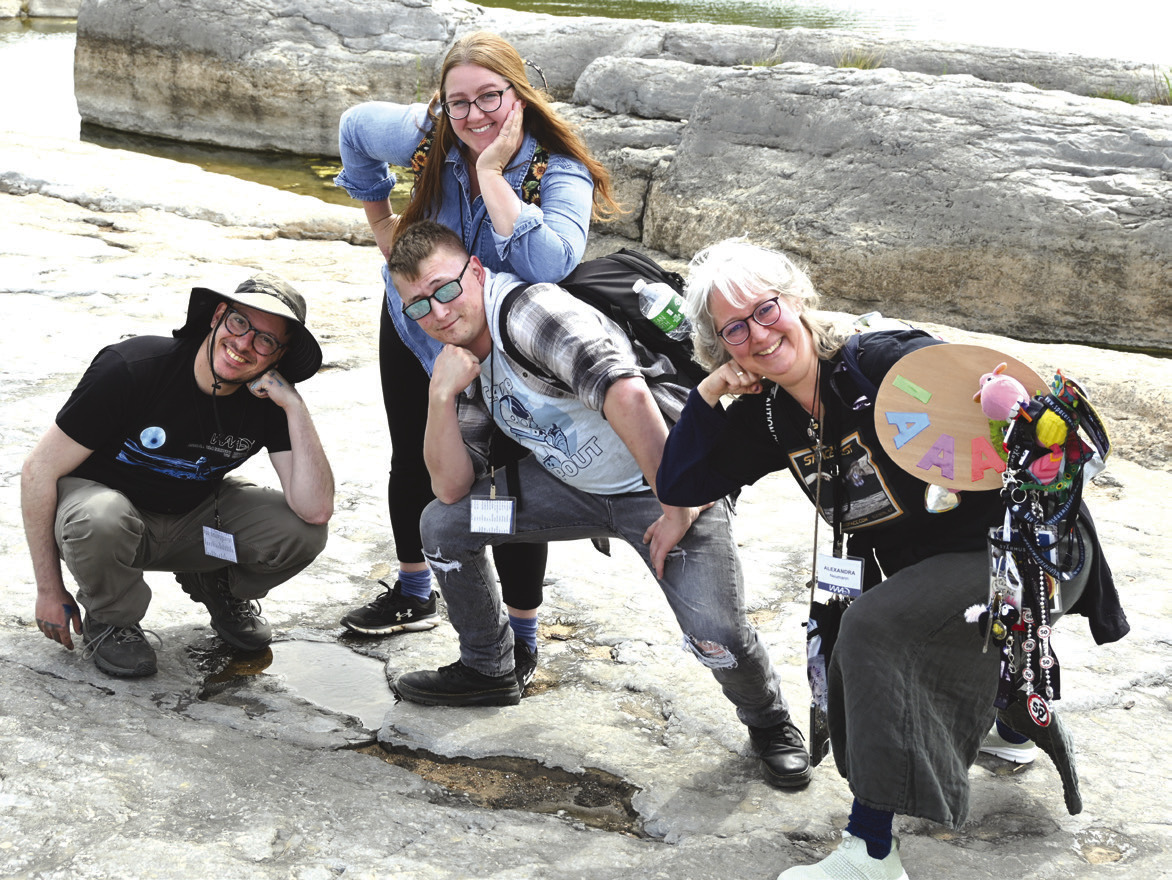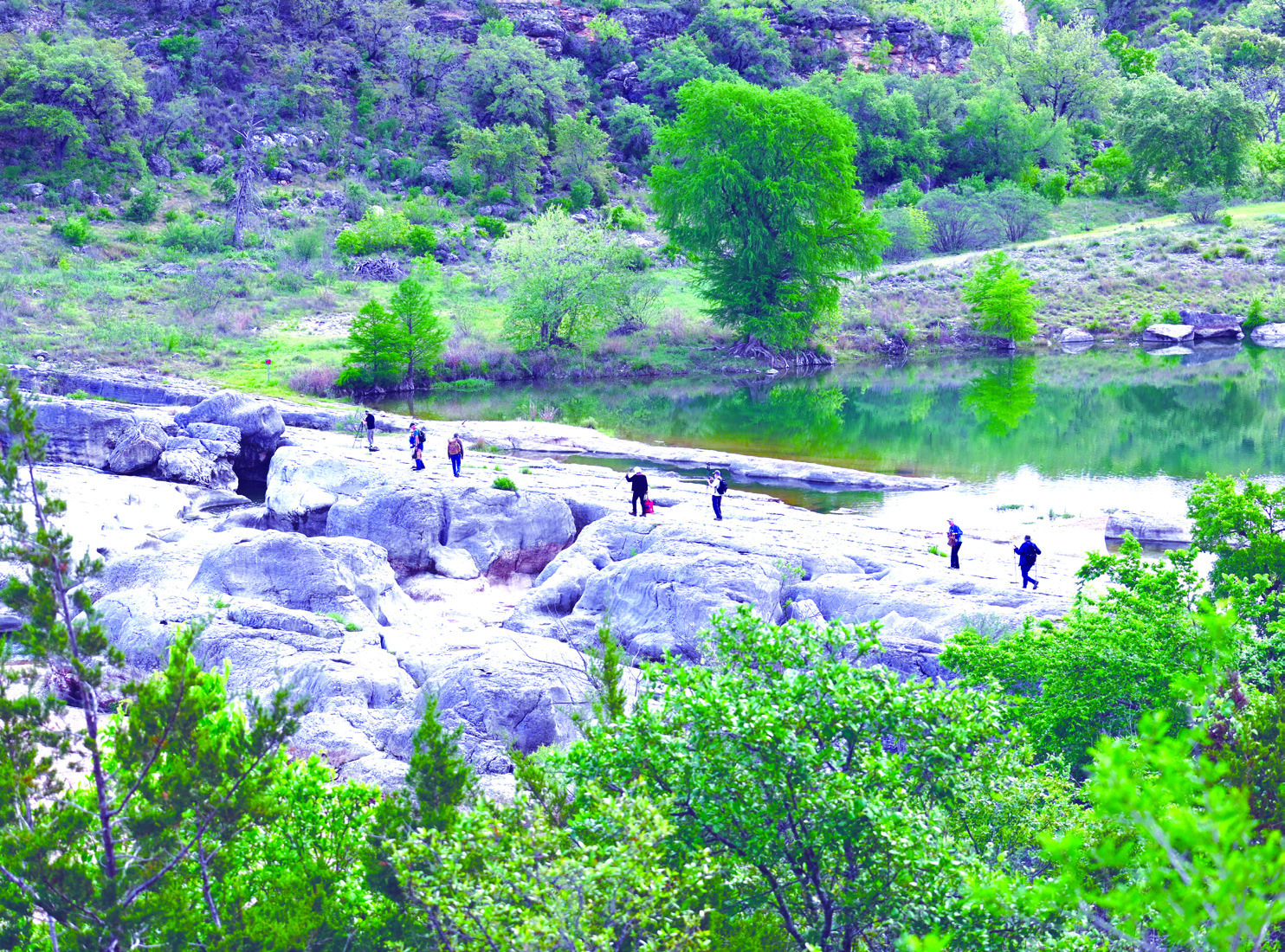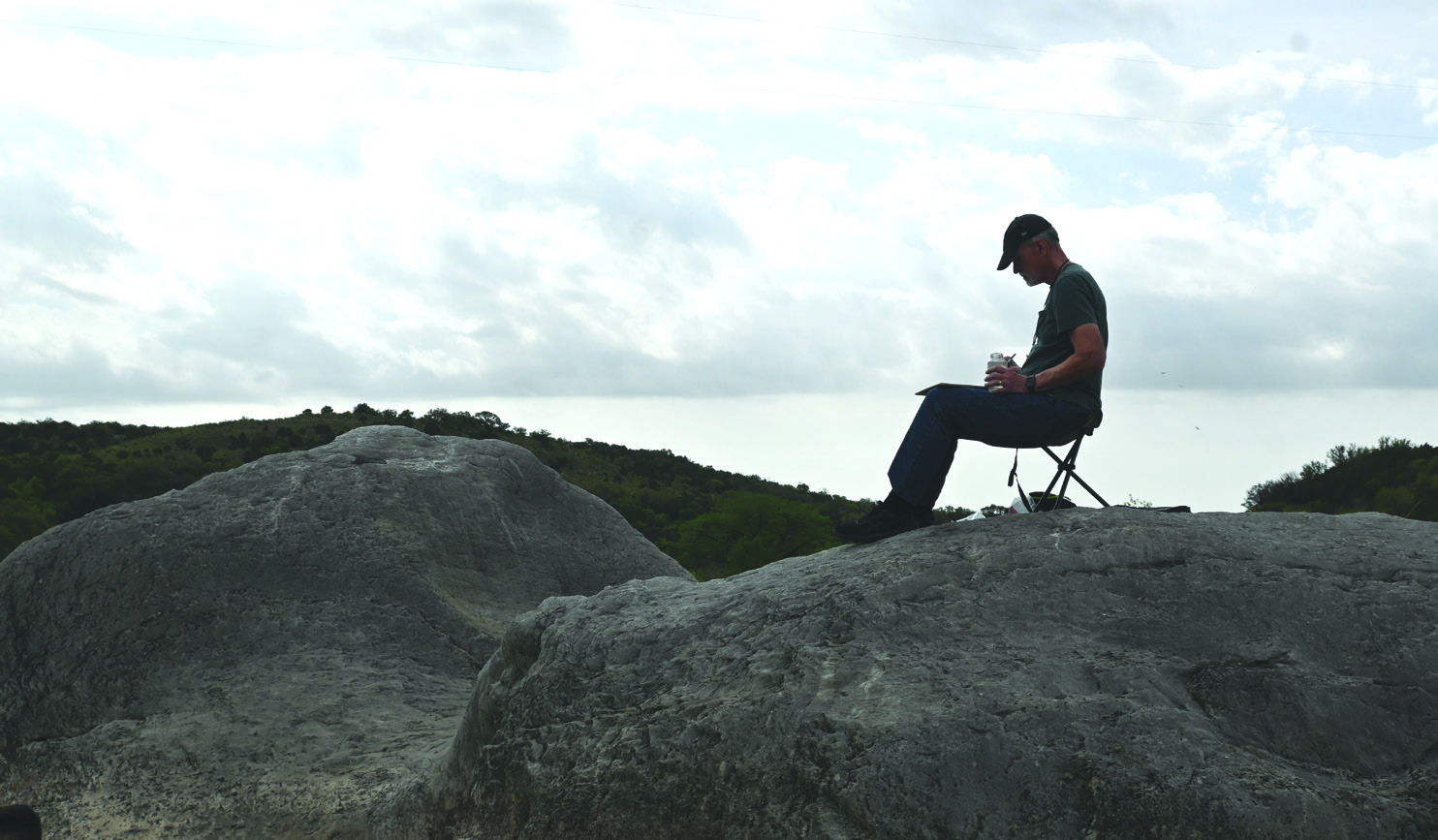If you’re an artist required to paint the landscapes of other planets, how do you go about doing that? It’s not like you can climb aboard a spacecraft to make a few preliminary sketches of your subject matter.
Just ask Wimberley resident and space illustrator Pat Rawlings. Last weekend, he hosted 33 members of the International Society of Astronomical Artists, of which he is a member, to witness the 2024 eclipse and to visit landscapes that could be useful in their depictions of extraterrestrial terrain. In particular, Rawlings found a landscape that resembled the alluvial erosion of the frozen methane terrain on Titan, one of the moons of Saturn. Titan’s surface is sculpted by flowing methane and ethane, which carves river channels and fills great lakes with liquid natural gas. No other world in the solar system, aside from Earth, has that kind of liquid activity on its surface.
Roughly a billion miles from Earth, a trip to Titan requires a journey of at least seven years. Fortunately for this group of accomplished artists, a trip to Pedernales State Park with its 300 million-year-old tilted and layered stairsteps of limestone, proved to be an easy alternative.

YOUNGER MEMBERS OF THE INTERNATIONAL ASSOCIATION OF ASTRONOMICAL ARTISTS STRIKE A POSE.
In a superb career spanning 30 years, Rawlings has documented the world of space exploration. His paintings, digital images and designs have been reproduced in hundreds of magazines, books, television programs and films in the U.S. and abroad. To ensure that his work rings true, Rawlings consults with astronauts and experts in spacecraft design, mission design and operations, planetary geology, meteorology and other related fields.
His art has been on the cover of Aviation Week and Space Technology on a number of occasions. He has produced artwork for NASA, The Ballistic Missile Defense Organization, Lockheed, Ballantine Books, Time-Life Books, Scientific American Magazine, Encyclopaedia Britannica, Air and Space for Smithsonian Magazine, Walt Disney Television Productions, and IMAX Space Films, to name a few. His design of all the spacecraft and the colony in the 3D IMAX film, “L5: First City in Space” garnered national critical acclaim. “Pale Blue Dot”by Carl Sagan featured a dozen of Rawlings’ paintings.
As a member of “I triple A,” the quickname for the International Association of Astronomical Artists, the group meets for art workshops that influence their illustrations. They have met in remote locations like Iceland, Death Valley, Hawaii, The Colorado Plateau and Meteor Crater, to paint geology common to what has been discovered on other worlds. Most of the members have a background in astronomy, physics and mathematics which enables them to accurately interpret the data from observatories and space probes, which they also visit, and convert them into believable images.
Member and former president of the IAAA, Kara Szathmary who attended the Wimberley event explains that “space artists must study geology of the Earth and other worlds and find terrain that bears similarity to the geology of Mars, Venus or a host of other targets. If geo-physics is the same everywhere in our universe as the laws of physics currently imply, then landscape artists have the opportunity to travel to locations on Earth where cosmonauts and astronauts rehearse for extraterrestrial space exploration.”
Senior members of the IAAA like current president Aldo Spadoni have long careers with achievements that are, well, out of this world. Spadoni has contributed to the design and development of numerous advanced aircraft, missiles, and spacecraft for NASA, the U.S. Air Force, Navy and other groups. He worked with hard science fiction authors Larry Niven and Jerry Pournelle and is a technical consultant and concept design-er who has worked on the films “Apollo 13,” “Supernova,” “Ironman” and “Ironman 2,” among others. Another attendee, Michael Mackowski, is a former electrical systems engineer for Orbital ATK, now Northrop Grumman. Also attending was super pilot Mark Pestana who spent more than 30 years with the U.S. Air Force and NASA, working on projects related to the International Space Station and the Soyuz Spacecraft that shuttles people to the ISS. Michael d’Albertis, a former Air Force Reserve Lieutenant Colonel with a Masters Degree In Aeronautical Science specializing in aviation and space operations, was the first president of the IAAA.
Photorealistic space artist Walter Myers, a computer graphic artist, has been published in nearly every media format available for a long list of clients.
Younger, newer members of the group like Daniel Dahan, Chris Wade, and Ken Davy spent time with the senior members who were more than happy to share their experience with them.
After their plein air painting session at Pedernales, the group spent eclipse day at the appropriately-named Moondance Ranch, a 250-acre private property in the hill country. On Tuesday, the group plans to travel to Enchanted Rock, the 425 foot granite dome in the Llano uplift north of Fredericksburg and then on to south Austin to the NASA contractor ICON who has a contract to develop prototype 3D printed habitats on the moon.

MEMBERS OF THE INTERNATIONAL ASSOCIATION OF ASTRONOMICAL ARTISTS GET THEIR FIRST LOOK AT PEDERNALES FALLS LANDSCAPE. PHOTOS BY TERESA KENDRICK

IAAA PAINTERS AND ILLUSTRATORS WALK THE LIMESTONE LEDGES OF PEDERNALES TO SET UP FOR A PLEIN AIR PAINTING SESSION

WIMBERLEY IAAA MEMBER AND HOST PAT RAWLINGS AT WORK.










